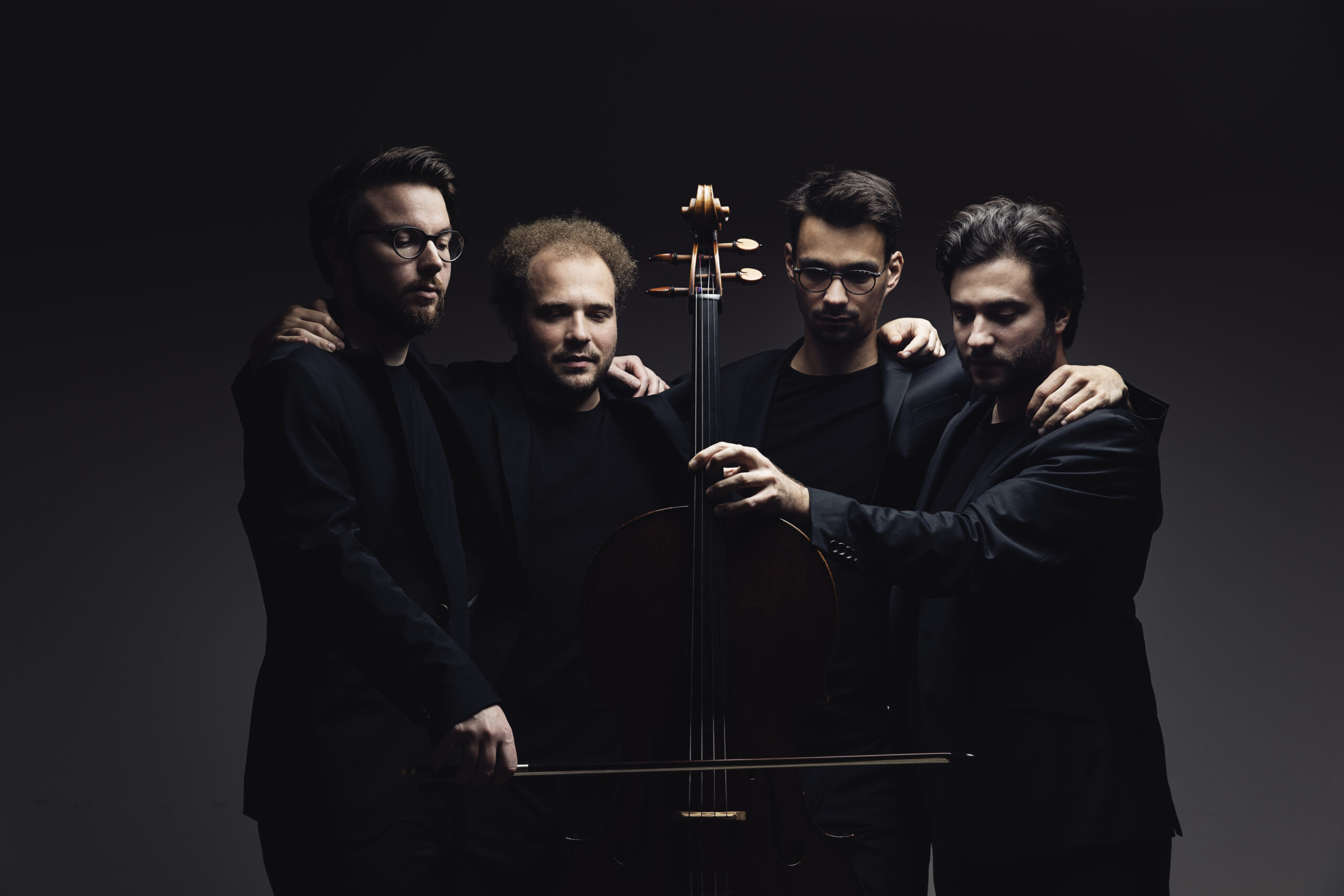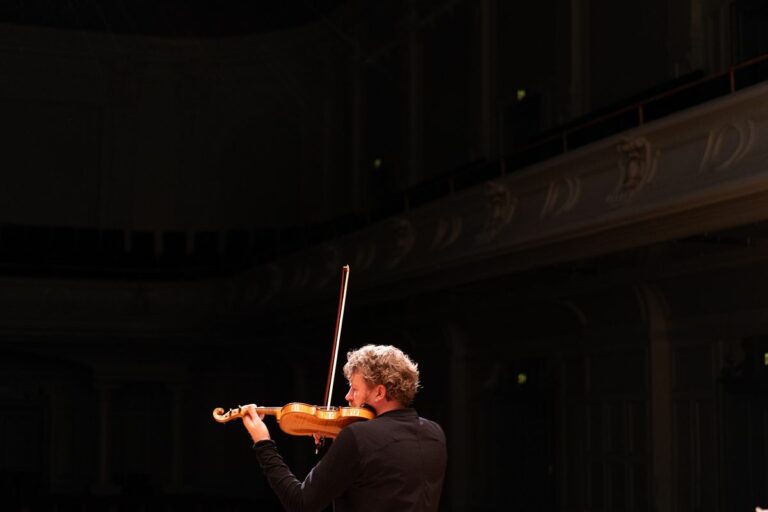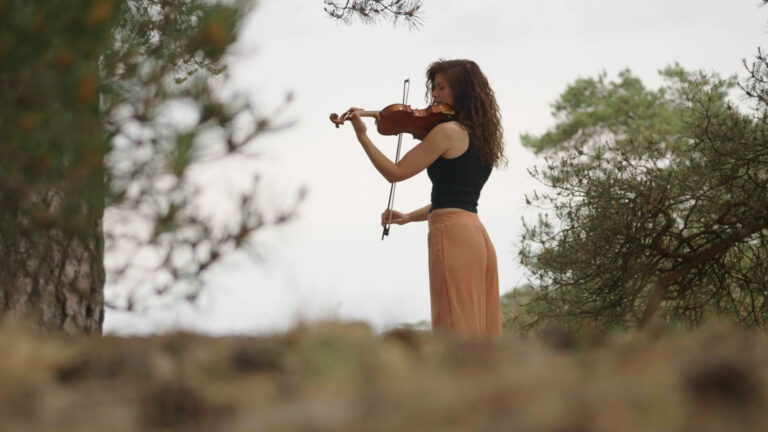Dit evenement heeft al plaatsgevonden. Benieuwd wat er nog meer op het programma staat? Bekijk de agenda!

Klassieke muziek
Hoor bij ons!
Goldmund Quartet
Haydn, Schubert en Bacewicz
-
Datumzo 14 dec 2025
-
Tijd11.30 - ca.13.10 uur
-
LocatieStadsgehoorzaal
-
Prijs€ 35,00
-
ZaalAalmarktzaal
-
InclusiefPauze en drankje
Haydn Strijkkwartet in Es op. 33/2 ‘de grap’ | Bacewicz Strijkkwartet nr. 4 | Schubert Strijkkwartet nr. 14 in d, D810 ‘de dood en het meisje’
Goldmund Quartet
Het Duitse Goldmund Quartet is beroemd vanwege de bijzondere instrumenten waar ze op spelen: de Nippon Music Foundation heeft hen in 2019 het ‘Paganini-kwartet’ beschikbaar gesteld, de vier Stradivarius-instrumenten die Niccolo Paganini in de vroege negentiende eeuw bij elkaar had verzameld. Dat de instrumenten van het Tokyo Kwartet over zijn gegaan op het Goldmund Quartet zegt alles over de muzikale kwaliteiten van het Duitse kwartet: zij zijn de wereldtop en de instrumenten zijn bij hen in de allerbeste handen.
Strijkkwartetten van Haydn, Bacewicz en Schubert
Joseph Haydn was de vader van de symfonie en de moeder van het strijkkwartet. Van beide genres was hij niet de uitvinder, wél de vormgever. Hij ontwikkelde de vierdelige standaardvorm van de symfonie en tilde het strijkkwartet naar een totaal ander niveau. Maar hoe serieus hij ook is over het strijkkwartet, Haydn is altijd wel in voor een grapje. Dat blijkt wel in het vrolijke Strijkkwartet in Es op. 33/2, met als bijnaam ‘de grap’. Wat de grap dan is? Daarvoor moet u maar naar het concert komen.
Schuberts Strijkkwartet nr. 14 in d, D 810 ‘De dood en het meisje’ is – zoals de titel doet vermoeden – het tegendeel van grappig. Het thema is dan ook: de dood als minnaar, Eros en Thanatos. Als romantische twintiger greep Franz Schubert in zijn Lied Der Tod und das Mädchen terug op die oude fascinatie. Zeven jaar later nam hij dat Lied als basis voor zijn veertiende strijkkwartet, een genre dat hij net écht onder de knie had. Er was in de tussentijd veel veranderd: Schubert verlangde nu daadwerkelijk naar de dood, steeds heviger en oprechter. Het was zijn enige uitweg uit een leven vol armoede en pijn, veroorzaakt door slopende syfilis.
Grażyna Bacewicz was de belangrijkste Poolse componist van haar generatie, maar na haar dood in 1969 raakte ze grotendeels in vergetelheid. Het Strijkkwartet nr. 4 uit 1951 is haar bekendste werk. Het is krachtig, meeslepend, zit vol volksmuziekverwijzingen en brengt de muziek van haar Tsjechische collega Janáček in gedachten.
-
zo 14 dec 202511.30 - 13.10 uur
Haydn Strijkkwartet in Es op. 33/2 ‘de grap’ | Bacewicz Strijkkwartet nr. 4 | Schubert Strijkkwartet nr. 14 in d, D810 ‘de dood en het meisje’
Goldmund Quartet
The German Goldmund Quartet is famous for the exceptional instruments they play on: in 2019, the Nippon Music Foundation made available to them the ‘Paganini Quartet,’ the four Stradivarius instruments that Niccolò Paganini had collected in the early nineteenth century. The fact that these instruments, once belonging to the Tokyo Quartet, have now passed to the Goldmund Quartet speaks volumes about the musical qualities of the German quartet: they are among the best in the world, and these instruments are in the very best hands.
String Quartets by Haydn, Bacewicz, and Schubert
Joseph Haydn was the father of the symphony and the mother of the string quartet. While he was not the inventor of either genre, he was its formulator. He developed the four-movement standard structure of the symphony and elevated the string quartet to an entirely new level. But despite his seriousness in the string quartet, Haydn was always up for a bit of humor. This is evident in the cheerful String Quartet in E-flat Major, Op. 33 No. 2, nicknamed ‘The Joke.’ What the joke is? You’ll have to come to the concert to find out.
Schubert’s String Quartet No. 14 in D Minor, D. 810 ‘Death and the Maiden’ is, as the title suggests, the opposite of humorous. The theme is, after all, death as a lover—Eros and Thanatos. As a romantic in his twenties, Franz Schubert revisited this old fascination in his song Der Tod und das Mädchen. Seven years later, he took this song as the basis for his fourteenth string quartet, a genre he had only just mastered. Much had changed in the meantime: Schubert was now truly longing for death, increasingly and more sincerely. It was his only escape from a life full of poverty and pain caused by debilitating syphilis.
Grażyna Bacewicz was the most important Polish composer of her generation, but after her death in 1969, she largely fell into obscurity. Her String Quartet No. 4 from 1951 is her most famous work. It is powerful, captivating, full of folk music references, and brings to mind the music of her Czech contemporary Janáček.
-
zo 14 dec 202511.30 - 13.10 uur








